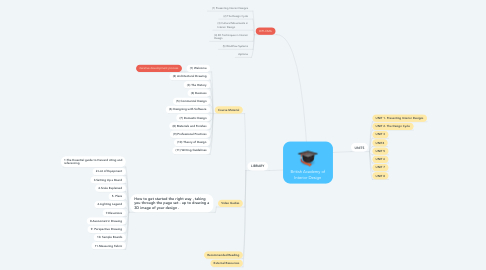
1. DIPLOMA
1.1. (1) Presenting Interior Designs
1.1.1. AIMS: (1) Learn how interior designers develop ideas and present them to clients. (2) Examine different presentation methods and produce a range of visuals for a client's living room.
1.1.2. (A) Researching interior design practice in the past and present
1.1.3. (B) Client briefs
1.1.3.1. What to include in a client brief?
1.1.3.1.1. (1) List of needs (requirements) (2) Understanding them (3) Timescales (4) Budget
1.1.3.2. 10 Questions to ask clients
1.1.3.2.1. (1) How much is your budget? (2) The time for the project? (3) How much for each item? (4) Specific brands? (5) Number of people using this space? (age, job, hobbies, activities) (6) Colours? Styles? (7) Indoor hobbies? Enjoy doing? (8) Specific requirements?
1.1.3.3. Client design brief template
1.1.3.3.1. PDF
1.1.4. (C) Site surveys
1.1.5. (D) Technical drawings
1.1.6. (E) Sample boards
1.1.7. (F) Designing visuals for client presentations
1.2. (2) The Design Cycle
1.2.1. AIMS: (1) Create designs for a studio apartment and learn about the stages of the design cycle (2) A structured approach to project development from initial idea to completed design.
1.2.2. (A) Interpreting a client brief
1.2.3. (B) Developing, selecting and testing ideas
1.2.4. (C) Techniques for spatial planning, model making and rendering
1.2.5. (D) Creating a design portfolio
1.2.6. (E) Colour rendering
1.2.7. (F) Evaluating client feedback and reviewing designs
1.3. (3) Cultural Movements in Interior Design
1.3.1. AIMS: (1) Examine how society, history, technology, economics and culture influences interior design practice. (2) Complete a research project to learn about key historical movements in interior design.
1.3.2. (A) Use research methods
1.3.3. (B) Analyse key movements in history
1.3.4. (C) Develop key insights about contemporary design influences
1.3.5. (D) Present research findings professionally
1.4. (4) 3D Techniques in Interior Design
1.4.1. AIMS: (1) Examine the properties, suitability and application of different materials for use in a large kitchen design. (2) Create a portfolio of 3D visuals and models using techniques that are central to interior design practice
1.4.2. (A) Design a residential kitchen
1.4.3. (B) Examine furniture fixtures and equipment
1.4.4. (C) Explore different materials and how they are used
1.4.5. (D) Create 3D visuals and scale models
1.4.6. (E) Examine health and safety issues in residential design
1.5. (5) Workflow Systems
1.5.1. AIMS: (1) Develop timelines, diagrams and templates for a workflow system that support the installation of a studio apartment design.
1.5.2. (A) Identify the sequence of activities needed to complete an installation
1.5.3. (B) Understand the relationship between design activities, time and resources
1.5.4. (C) Apply a workflow system to respond to challenges
1.5.5. (D) Develop a template workflow system for future use
1.6. diploma
2. LIBRARY
2.1. Course Material
2.1.1. (1) Welcome
2.1.1.1. iterative development process
2.1.2. (2) Architectural Drawing
2.1.3. (3) The History
2.1.4. (4) Business
2.1.5. (5) Commercial Design
2.1.6. (6) Designing with Software
2.1.7. (7) Domestic Design
2.1.8. (8) Materials and Finishes
2.1.9. (9) Professional Practices
2.1.10. (10) Theory of Design
2.1.11. (11) Writing Guidelines
2.2. Video Guides
2.2.1. How to get started the right way , taking you through the page set - up to drawing a 3D image of your design .
2.2.1.1. 1.The Essential guide to Harvard citing and referencing
2.2.1.2. 2.List of Equipment
2.2.1.3. 3.Setting Up a Board
2.2.1.4. 4.Scale Explained
2.2.1.5. 5. Plans
2.2.1.6. 6.Lighting Legend
2.2.1.7. 7.Elevations
2.2.1.8. 8.Axonometric Drawing
2.2.1.9. 9. Perspective Drawing
2.2.1.10. 10. Sample Boards
2.2.1.11. 11.Measuring Fabric
